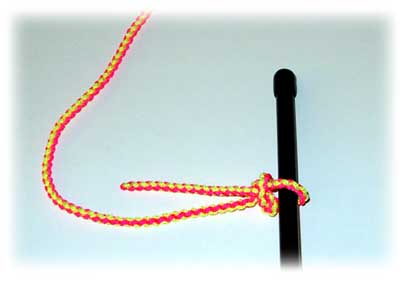
One of the most traditional falconry activities is trapping. Long before it was discovered how to breed and raise birds in captivity, birds had to be trapped to be used in falconry. In the United States only those who are permitted through a trapping permit, banding permit, or falconry permit may trap a raptor. If you have a nuisance raptor and intend to trap it to remove it, please be aware this is not legal - you will need to call your state Fish and Wildlife department for further guidance, and may need to contact a falconer, a wildlife control company, the USDA, or others depending on the species and the situation.
Special thanks to falconer and Master Bander Al Ingram for sharing his experiences and insights.
Safety
Safety is the most important factor in trapping - and that is safety of the bird, not of you. The last thing falconers want to do is injure any bird, particularly a potential hunting partner. However, accidents may happen. The falconer must take precautions to ensure that injuries do not occur. The traps referenced here can all be used safely, and most of them are routinely used and recommended by governmental agriculture departments, wildlife rehabilitators, and scientists who band birds for study. Trapping the bird can be done without hurting her in any way. First, do no harm.Most traps should never be left unattended. A trap may be set and the falconer may move off to allow a bird to become ensnared, but the trap is never left unattended. A bird ensnared may panic and need to be released or tangle herself up badly if left for long. A bird ensnared is also a welcome sight to other predators. Never lose sight of your trap. Bring binoculars if necessary to keep view of your trap, but monitor it well. The exception to this is the Swedish Goshawk Trap.
Your trap should always be weighted with a weight heavy enough that the bird cannot carry the trap any distance, however it should "give" so that an ensnared bird does not hit the end of the trap and come to an abrupt halt. The trap weight must be appropriate for the type of bird you are trapping. A railroad spike, horseshoe, or two lengths of rebar work well for a Bal-Chatri for a Red-Tail. A length of suitably weighted chain also works well as the effective weight of the trapping mechanism gradually increases as the bird attempts to carry the trap. If more weight is needed for this type of bird, be sure to use a shock cord to attach the weight to the trap. If the bird can carry the trap at all, she will in a panic. Make sure that the trap is properly weighted and attached to a shock cord, if necessary.
Some states require that your trap be labeled with your name and contact number. Although this is not a requirement in all states, this is a good practice.
If you are trapping in a game rich area, such as trapping Kestrels in 80° weather where the grasshoppers are thick, you will likely have a hard time drawing any birds to any setup that looks even slightly off - there is just too much other choice that is easy and safe to go after. Be sure to select your trapping opportunities when you will have the success you want. Morning is the best time, right at dawn, for many birds as they are hungry and have likely just cast. Evening may work well, too, as birds who have not eaten that day may feel desperate to eat and come down to a trap. Cloudy weather tends to be better with more game holding tight. A cold spell where birds are expending more energy and looking for more food helps. The location to trap is also critical. Trapping Kestrels or Red-Tail Hawks will probably take you to farm land area. In Washington, Ellensburg and Quincy are noted as Kestrel trapping areas, and the Skagit Valley is excellent for Red-Tail Hawks.
When trapping you will want different sized hoods as you won't know the size that the bird will need. Cat muzzles in different sizes with velcro closures or golf club covers with velcro closures can be effective temporary head covers until the bird is secured and a well-fitting hood can be used. Be aware that your bird likely has casting material in it that it will need to cast up. Keeping it in a completely dark room unhooded is one way to handle a fresh trapped bird who may have a casting, or having a well fitting hood that has plenty of room for her to cast through the hood is another option. The temporary cat muzzle solution won't allow the bird to cast and is only a short term solution until a better hood can be found. Controlling her stress is important during this time. A bird will also be cast temporarily to prevent her from injuring herself or others. Painter's masking taps (the blue masking tape) is excellent for this. It can be balled up and placed in each foot with the foot taped around the outside, and the stocking can be taped around the bird securely but without constricting her. Tails can even be taped with this as the Painter's Tape won't stick to feathers too badly, although Gum Tape is better for taping up an Accipiter tail. An alternative for taping the feet is frequently used on rehab birds. The middle front toe can be hyper-extended and taped up to the highest point it can extend upwards to with a loop of tape around the back of the leg. This will even prevent an eagle from grabbing when done right, although the ball in the foot is preferred, this can be done when the foot pad need to be examined or worked on.
After trapping, consider if you should conduct a basic exam or have a veterinarian do a basic workup looking at the bird's general health. Things to examine include:
- Fecal exam - observing consistency, color, smell, and doing a fecal float for parasites
- CBC blood workup checking red blood cells, white blood cells, liver and kidney functions, and any blood parasites
- Tracheal, crop, and cloacal swabs checking for infection
Bait
As important as the trap is the bait. Pigeons, starlings, sparrows, zebra finches, and mice all make good bait. If trapping Kestrels, grasshoppers can be used, too, although sparrows or Zebra Finches with a Dho-gazza trap work wonderfully. Kestrels also like mice. The most important thing for bait is that it moves around a lot. Because of this most people working use two mice together, or a mouse and a sparrow (or a mouse and a finch) together, or otherwise have active bait. If white mice are the only thing available, some falconers will take a non-toxic safe black or brown magic marker and color up the mouse a more agouti color. Since Zebra Finches tend to sit side by side, creating a perching situation in a trap where there is a perch halfway up the trap, as in a pyramid BC, that will spin and barely fit two birds will keep the finches moving inside the trap.Bait selection also must be made based on the species intended to be captured. Red Tailed Hawks do well with mice, rats or even birds while Cooper's Hawks will be more likely to be caught when pigeons, sparrows, or starlings are used.
Mice are easily available by trapping any non-native mouse species such as the house mouse., what some people may casually refer to as "field mice" as they are found in homes or barns. Darker mice are far preferred to lighter mice as it more closely looks like the native coat patterns. If you are keeping the mice for several days, they can be kept in a coffee can with holes punched in it, provided with plenty of newspaper and paper towels for nesting in and shredding, and plenty of succulent vegetables to eat so that they are well nourished and hydrated. Some trappers keep the mice as pets and will use them year after year while others release the wild mice or English Sparrows they caught for bait. The point is that these are animals, too, and the intent is to not injure them during the trapping.
Starlings can be trapped with a nest box type trap using dog food, bread, hen scratch, or tortilla chips as bait. Often they can be found around a commercial area such as a fast food restaurant, Wal-Mart or Safeway. An elevator trap can also be disguised as a nest box with good success. They can be kept in a cage of 1" x 1" mesh on a high protein diet such as cat kibble and clean, fresh water until they are ready to be used. Beware that they are quite messy. English sparrows can be trapped with a V trap using white bread, chicken scratch, popcorn, or bird seed as bait. They can also be trapped in a 1/4" welded wire cage about 12" x 12" x 24" with a hinged trap door at the top and a funnel opening about 3.5" narrowing down to 2". Many report that leaving a bird in the trap helps attract more birds and that any setup left out as a bird feeder when not being used to trap help acclimates many birds to the setup making them less wary. Many have reported that elevator traps tend to catch too many native sparrows instead of English sparrows whereas the V trap or funnel does not. English sparrows are difficult to keep in a cage. A cage can be made for them out of a small wooden frame with white cotton fabric stretched over it. Estimate one square foot per English sparrow to prevent bickering and stress. English sparrows are very territorial and will be aggressive towards each other. They are best kept in a soft sided cage, such as one with the walls made out of cotton fabric like an old sheet or pillow case, and with sufficient size for the birds.
Sparrow trap https://www.youtube.com/watch?v=R1vaX0KWY34
Sparrow trap https://www.youtube.com/watch?v=23Jeup5e2AI
| Here a pigeon in a harness is set as bait for a mist net. | 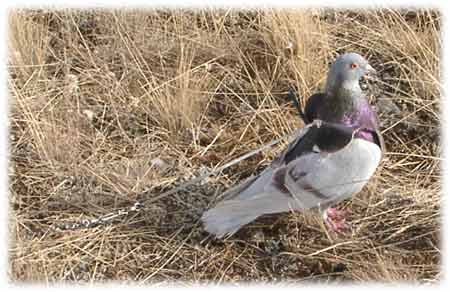 |
| Here mechanical pigeons are being prepared as bait for a mist net. The mechanical pigeon can be powered to do the work of enticing a raptor to check out the net, then the real pigeon can be raised to entice the raptor to stoop into the mist net. | 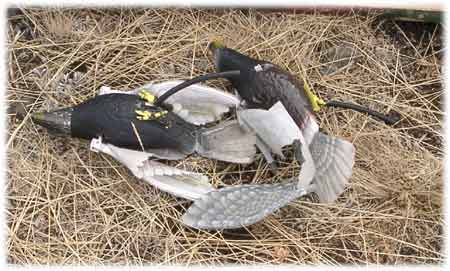 |
Traps
There are two main types of traps - nooses and nets. Nooses depend on a set of tiny nooses to ensnare a bird's toes. Some nets are made to enclose around the bird's entire body and entrap the whole of the bird and some catch the birds as they fly into the structure.If you are trapping on the ground, flat black is usually the best color for any trap. Mist nets or Dho-Gazzas may be other colors depending on the light and background. If you are trapping on snow, you will want a white trap.
Nooses
The biggest difference between noosed traps is the way that the nooses are arranged. Originally, nooses were made of fibers such as horse hair. Today they are made of high-tensile fishing line such as 30lb Maxima Chameleon monofilament. Well-made and well-used noose traps are among the safest and easiest to use. The bird is caught rather quickly and is easily untangled, and therefore stressed less.Some falconers believe that nooses must be locking so that when they contract around a bird they lock in their smallest position. The problem with locking nooses is that they can damage the bird's circulation. If a bird happens to get free of the trap and a noose is stuck on her, she could lose a toe or leg due to the damage. When a bird hits a trap and a noose closes, that bird's reaction is going to be to tug. The action of tugging will keep the noose tight around her until you can get to her. There is a possibility of losing a bird on a trap with a non-locking noose, but the potential problems are less. I have never lost a bird with non-locking nooses, and many master banders prefer them.
Bal-Chatri or BC
The name "bal chatri" is Hindi for a child's umbrella. Developed in India, the Bal-Chatri trap is a wire container that is covered with nooses with bait inside and is a favorite of bird banders, researchers, falconers, and others. The Craighead brothers reported on using bal-chatri traps in the 1940's in National Geographic. Fran Hammerstrom is famous as being the first biologist in the United States to make use of the BC and published its use in scientific literature. These can be made in many shapes with a simple box being the easiest. Bait, such as mice, is placed inside the wire box and nooses are attached along the top. A bird flies down to strike the mice and instead strikes the wire box. In attempting to back off, the bird's toes become entangled in the nooses. A length of chain attached to weights can be a very effective weight also adding drag making sure the bird cannot get away with the trap. Be sure to add an appropriate amount of chain depending on the species you are trapping, but also the species that might hit the trap. You may be after Cooper's Hawks, but a Red-Tailed Hawk might strike the trap. Have enough weight that these larger birds won't be able to carry the trap away.
A simple BC can be made of 1" hardware cloth and rebar. Although some sources refer to chicken wire being use, the holes are big enough that mice escape, and the chicken wire is not strong enough and will collapse when struck well by a good sized bird. Shape the hardware cloth into a box about 3" tall by 14" long. Make sure that wherever wire joins wire you attach it with 18 gauge copper wire. Attach the rebar strips onto the sides with 18 gauge copper wire, or use fishing weights to sufficiently weigh down the trap, and spray the trap with flat black spray paint for trapping on most ground cover; you can even spray lightly over the top with a bit of spray adhesive and roll it in some loose dirt to help camouflage it better. Attach the nooses around the top, about 40 for this size of a trap. If you get too many nooses, they get in the way of each other. You only need the bird to get caught on a couple to have her secured. One note about the BC is that mice are attracted to the nooses and will nibble on them. Placing some carrots or apple slices into the trap with them will help them nibble on something other than your nooses. Make sure you have a trap door on the bottom of the trap for the mice to be loaded and unloaded. Larger traps can be made 16" x 10" to hold a pigeon or two.
A fancier trap can be made with a slightly taller box on the outside containing a smaller wire box inside. This double box system will keep the mice from nibbling on your nooses, and ensure that your mice are not injured. Leaves can be placed along the bottom making for a more natural appearance and a bit of rustling as the mice move around, particularly if trapping owls where the noise will be important. Some natural grasses can be woven across the top to make for a more natural appearance, if necessary. In very cold weather, small hand warmers can be placed under the trap to keep the mice comfortable.
This same design can be used as a bait container for other traps, such as a Dho-Gazza. Just don't apply the nooses to it.
Bal-Chatris can come in many other shapes. You can create a half-cylinder, a "top hat", a pyramid, or a full dome. A rolling BC can be created by making a wire cylinder 14" long and 10" in diameter and attaching "wheels" onto the sides weighted in the center so as not to interfere with the rolling action. These are easy to toss out and allow to roll in any direction. A bird will step on it causing the trap to roll and she will try to gain a higher footing further entangling herself. Nooses need to be placed all the way around this style of BC.
This is an extremely effective trap which is easy to use and is particularly well-suited to Red-Tail Hawks or Harris' Hawks. The same trap, noose size, and bait can be used for Red-Tails, Cooper's Hawks, and even Great Horned Owls. This is a very versatile trap. I have heard from some trappers that Merlins come in so fast that even the weight of the BC trap itself can be a danger to them and other traps may be better for Merlins. While nobody reported actually incurring injury, in watching the style of the Merlin's approach, there was a sense that an injury could more likely occur with a Merlin and prefer Dho Gazza traps or Hoop Traps. English sparrows make great bait for Kestrels in this trap. A clear plastic bag can be placed inside a BC full of grasshoppers to attract Kestrels.
Pigeon Harness
| This is basically a jacket that goes around a pigeon that is covered in nooses. The jacket is then tied to a weight tethering the pigeon in place so that it can fly up 5 or 10 feet, but no further. It is best to use a shock cord for this line to prevent either the pigeon or the hawk from injuring themselves tugging against the weight. However, the weight must be heavy enough that the hawk will not be able to drag it. A starling with an 8 oz lead weight attached to a 8' cord is enough for any bird except a eagle. When there is a possibility that an eagle will be lured in by the trap, a 1 lb weight is sufficient. A bird comes in to strike the pigeon and gets entangled in the nooses. When a bird strikes, you should wait about 10 minutes before making in. Sometimes a pigeon can be tossed from the car or ATV in very rural areas when a falcon has been spotted with this setup in place. Some falconers swear that smacking their hand against their car door as they toss the pigeon helps attract the falcon and gives an appearance that the pigeon was hit by the car.
One practice that is becoming more common is to use toy birds covered in a pigeon harness. Several falconers have reported great success with this, particularly noting that Merlins appear to like the toy pigeons even better than real bait. The toy birds flutter just like the real ones and are easier to work with. |
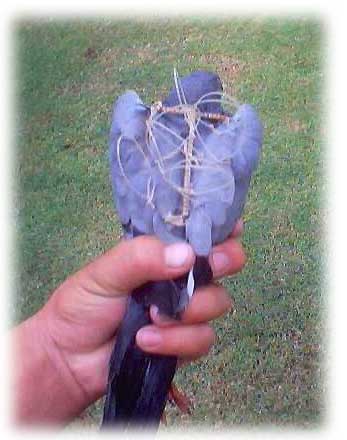 |
Noose Carpet
This describes anything that is covered in nooses. Commonly chicken wire is used as it can then be used to wrap another object, such as a duck, or can be laid on the ground or in a site where a bird is certain to land.
Hoop Trap or Phai, Phi, or Pa-Dam
| Originally, these were individual nooses staked out around bait developed by Indian falconers centuries ago. Now they are a set of nooses attached to a hoop of wire which is then laid around a centrally located bait.
Commonly a small bird such as a sparrow or starling is attached to a 1" line and set in the middle of the circle. Raptors see this as an easy scoop-up-and-fly-away meal. A small hawk will fly in and become entangled in the nooses. Particularly good for Merlins, Sharp-Shinned Hawks, and Cooper's Hawks. A good hoop can be made from 0.18" or 0.20" fish tape with the nooses made of 28 gauge steel wire (so far only found at Ace hardware). The trap itself is very light weight and must be attached to a heavy sandbag or other weight; again, it should be attached to the weight with a length of shock cord. This trap is excellent in a field with a little height to the grass as the grasses then hide the nooses standing up. This is particularly effective on Prairie Falcons, or really any falcon. It is possible to trap a Red-Tail with this, but not the best way. |
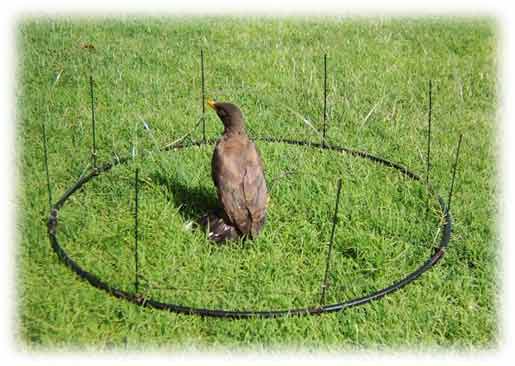
Photo courtesy of Salman Ali. |
Nets
These are just what they sound like - various ways to wrap a bird in a net. Nets have a tendency for tangling on a bird, and for breaking feathers. A larger size mesh tends to tangle more than a smaller size mesh. However, a larger mesh will have less drag on something like a bow net.Dho-Gazza or DG
This is an Indian trap consisting of a net that collapses around the bird as the bird flies through. This is particularly good for falcons. It may be more stressful for the bird, the entangling can be significant, and it can take some time to sort the bird out many times requiring cutting the net to free the bird without stressing her or damaging feathers. Toenail clippers are good for this being easy to clip the net and highly unlikely to cut the bird. The premise is that bait is set a few feet away on one side of the trap and the bird flies to it from the other side of the net. When it strikes the net, the net closes around it like a drawstring bag. Bait for this can be anything, although English sparrows or starlings work very well. Some falconers make their own netting using #3 tri-filament Dacron for a variety of birds from Kestrels to Peregrines, #6 tri-filament Dacron for Goshawks or Red-Tailed Hawks, and #12 tri-filament Dacron for eagles. Most commonly the thread is waxed before it is tied with a reef knot. Nets are typically wetted and stretched with bungee cords as they dry to help them take shape. The larger the net squares are, and the thinner the cord, the less likely that a bird will see the net. Many report that a net square size of 2.25" x 2.25" square is the most versatile size for the net squares allowing small Merlins through large Goshawks to be trapped. The full size of a very versatile net may be 4' x 10'. Others prefer nets sized 2' x 4' with 3" squares for Merlins scaling the net size up for larger birds.
One drawback of this trap is that it can take a little bit of time to set up. Once you identify a bird to be trapped, you need several minutes to set this trap up and move away from it. A bird could be unsettled by that much motion or could lose interest. Many trappers prefer the Bal-Chatri because it is easier to set up and it is less stressful on the bird.
Setting up a Dho-Gazza
Materials
- Two 1/4" pot roll poles (for a Red-Tail)
For a Merlin or Kestrel, you can use a portable frame made of wire coat hangers roughly 18" high by 28" wide. - Angler Pro Braided Dacron - 20# black
- Net
A gill net from a fishing supply store will suffice - use 3" for Red-Tails and Sharpshins, maximum diagonal measurement for a Red-Tail is 4". For a Red-Tail this needs to be roughly 30" high and 5' across.
The nets come shaped into diamonds, so reshape it into squares and cut it to size. Dye it black with Rit Dye. - One hammer
- Four plastic tabs (Take black electrical tape cut into 2" lengths and fold it onto itself so there is no sticky part)
- Four paperclips
- Dental Floss
- Scissors - just in case
- Length of heavy chain or heavy weight to secure the net
- Take your two tall poles and hammer them into the ground securely.
- At the top and bottom of each pole attach a paperclip using dental floss.
- Take your net at one of the top corners. Fold the plastic tab around the corner of the net and affix to one of the paperclips.
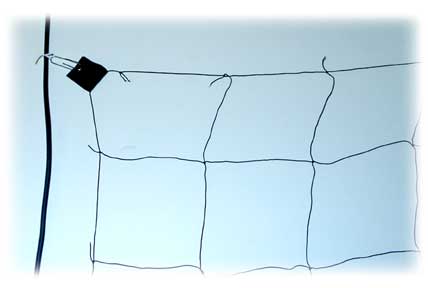
- Repeat on the other three corners. Your net is now fully suspended.
- Knot one end of your Dacron string to the bottom of a stake or to a sandbag.
- Around the perimeter of the net, weave the string in and out of the holes. This doesn't have to be tight; you want it to just wrap the net around the bird.
- Knot the other end of the Dacron string to the same stake or sandbag.
- On the far side of the net (the direction that your bird will be flying towards) set up a bait container about 2' away from the net with two mice or a mouse and a sparrow.
If a bird flies through the net and triggers the trap, you will most likely lose your plastic tabs and possibly the paperclips. It's always a good idea to carry extras with you.
Bow Net
|
When set, this trap lays on the ground. When the bird comes in to investigate the bait, the trap is sprung causing the circle to release over the bird creating a net over the now trapped bird. These traps can be manually pulled with a rope, can be spring loaded, or have a remote controlled release mechanism. A trap like this should be anchored well. With several ropes or lines to keep straight, many falconers have these labeled and sometimes will pass them through tubing (such as copper tubing) to keep them properly aligned and out of the way. The Mollen family at Valkensward, among others, were well known to use these traps to supply falconry clubs in Holland with Peregrines.
This trap can be made in two general sizes. A small Kestrel or Merlin size can be made using two rat trap springs on either side to flip the net over the bird. The bow sections can be made of 10 gauge wire. A bow net of this size would need a fine mesh net for the size of bird you would be catching. This works very well on all kinds of birds from Goshawks, Red-Tailed Hawks, Sharp-Shinned Hawks, Cooper's Hawks, and even eagles, but the bow needs to be the proper size for the bird. You can set this up with a pigeon as bait on a sloping hillside, then set the trappers slightly away in a blind, ice fishing shelter, or a tent to stay out of sight. Bal Chatri traps can be placed near so that the pigeon movement attracts birds from a distance and once close in they may choose to strike a BC setup. A larger size can be made of spring-loaded porch door hinges and a bow made of 1/4" x 1/2" aluminum. The larger size can take a slightly large mesh size of 1" to 1.25" made with 1/16" cord. Larger mesh (e.g. 1.5") for the netting will make it more likely that the bird will become entangled in the netting possibly damaging a feather, and certainly making it more difficult to extract the bird. Smaller mesh (e.g. 1/2") for the netting will make it less likely that the bird will become entangled. Smaller mesh made of thicker cord will slow the closure snap of a net making it more likely a bird will escape (particularly Accipiters), and can be more of a problem in freezing conditions. Thicker cording can be safer, and will likely be more durable. Springs for bownets can be purchased from McMaster-Carr http://www.mcmaster.com/ |
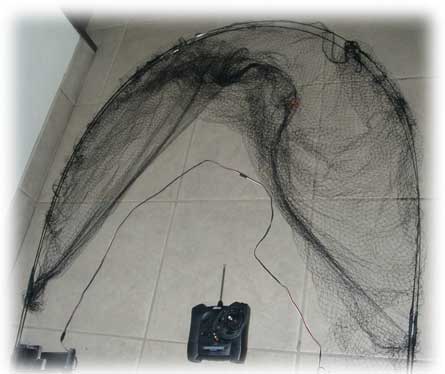 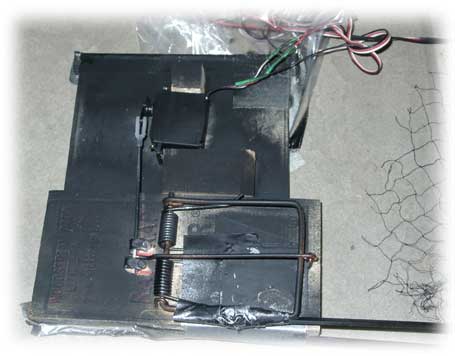 |
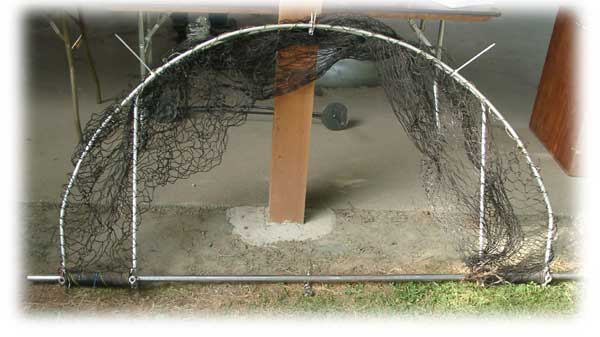 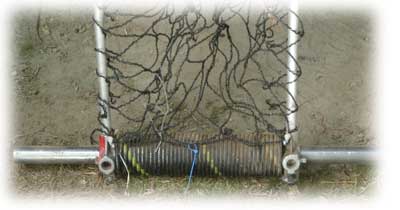 |
Mist Net
| This is a Japanese device and is basically a larger version of the Dho Gazza, but it doesn't collapse around the bird, and sometimes doesn't include bait. Often times this is strung out along migratory routes to catch migrating birds, especially small birds which are then recorded, banded, and released.
The mist net here is positioned on a migratory route banding station. Before setting a mist net, make sure to note the flight path and directions, and set the net in a place where a bird will be safe once it encounters the trap. The posts should be long enough (usually 8') to support the net even in wind, and some of the best are telescoping poles. The net should be kept loose and billowy so that it forms three horizontal sort of pockets. If the net is held too taut, birds can bounce off of it instead of being trapped. The billowy fold over pocket of about 4" - 5" at the bottom of each row allows a bird to strike the net and fall, or become trapped in its initial contact. There is a cage of pigeons in the foreground, each of which will take their turn being harnessed and set in an enticing position to lure a bird into the net. The white string in the foreground runs from the trapper, to a pulley on the net's frame, then down to the harnessed pigeon. When a raptor is looking over the setup, either a mechanical pigeon or a harnessed pigeon can then be raised and lowered fluttering and giving the appearance of an injured bird. Once a bird strikes the net, they are usually hopelessly tangled. The trapper must rush to the site, control the bird, and carefully detangle her from the net strands. A wary and experienced hawk will stoop at the net and pull up when they recognize that something is not normal. Less experienced birds will strike the net without hesitation. Another option is to have a lure pole which would be roughly 10'-12' long and approximately 20' from the net luring about 6'-8' off the ground. A setup might be made of materials such as two six foot sections of aluminum painter's poles with a wooden dowel installed at the top and a porcelain insulator to guide the lure line. |
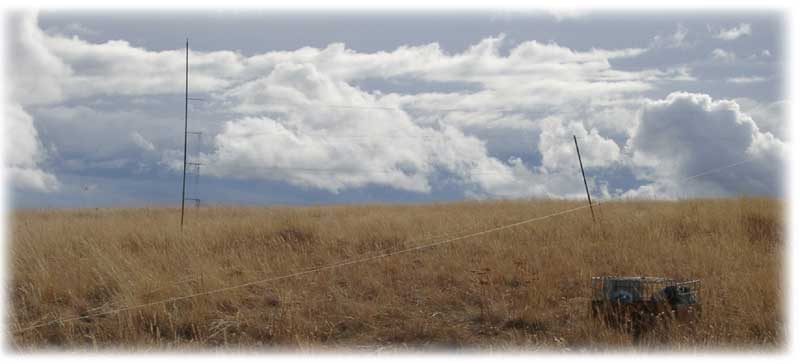 |
Other Traps
Swedish Goshawk or Swedish Goshawk Pen TrapA rather large construction, and may it be a permanent fixture. This is basically a large box made of wire mesh which has a top that opens up. Bait is set inside the box, or in a separate wire mesh compartment under the main area of the box, and the hawk or owl drops in from the top. The bird entering the trap triggers the two pieces of the roof to close behind it trapping the bird in the box. There are many versions of this ranging from a sliding top to a drop top, an A-frame, and even a double side slide. Works on all species of hawks and owls, but particularly well on Great Horned Owls. This trap should be at least 30" for a Sharp Shin Hawk and 42" for a Red-Tail Hawk. A 36" cube is a good all-around size. Applying netting on the inside of the box will help prevent the hawk from banging herself inside the box, particularly on the top frame. Tying the netting with soft cotton butcher's twine will hold it in a soft and springy manner. This will help prevent the bird from banging her cere.
https://www.modernfalconry.com/shop/?_route_=Swedish-Goshawk-Trap
Potter's Trap or a Treadle Walk-In Trap
Some find this easier to work with and trapping success is equal to that of the Bal-Chatri. The trap is triggered by pressure on the treadle. You can also add some Bal-Chatri nooses to the top of this.
"Yosef, R., and F. E. Lohrer. 1992. A composite treadle-bal chatri trap for Loggerhead Shrikes. Wildlife Society Bulletin 20:116-118."
Verbail Trap or Sliding Padded Pole Trap
This is basically a jaw trap that will close around a bird's leg. Rarely if ever used by falconers, this requires that the jaws be very well padded to prevent injury to the bird's leg. Mostly used for hawks and owls in depredation situations where they will tend to perch on a high pole before striking at their prey.
None
I have heard that Snowy Owls and Great Grey Owls can be trapped with a simple spinning rod. Casting out with bait, allowing it to run around, and then reeling in can work. These owls are very reluctant to let go of prey and can be scooped up with a net.
Species Preferences
Each species has certain tendencies. Sharpshin Hawks tend to strafe in a straight line and keep going, and are most easily caught in a mist net. Prairie Falcons will strike a trap and then tend to circle around and land in order to make another hit on the trap. They seem to commit and become determined to get their prey if they make a single hit. Holding back from a strike can allow a bird to make another pass.
More Information
General trap pageshttps://content.ces.ncsu.edu/owls
Marlow Stevens - The Net Maker Website down
Sparrow hawk trapping in Turkey https://www.youtube.com/watch?v=UHp7Yd5gUiI
Sparrow hawk trapping in Turkey, more https://www.youtube.com/watch?v=hutO8FDC2dU
More information http://uplandsandpiper1.tripod.com/id41.htm
http://www.purplemartins.com/Topics/Z-Trap/Z-Trap.htm
https://www.wildlifecontrolsupplies.com/Merchant2/merchant.mvc?Screen=PROD&Store_Code=NWS001&Product_Code=WCSRC24&Category_Code=NWSBT00
https://raptorresearchfoundation.org/files/2015/10/Chapter-12.pdf
https://www.cedarcreek.umn.edu/biblio/fulltext/Raptor%20Research%20Vol%2010%201976%20Fuller.pdf
https://www.pwrc.usgs.gov/BBL/homepage/add_cap_tech.cfm
Other plans: Journal of Wildlife Management, issue 35:832-835
Making Nooses
To make a good noose for a Bal-Chatri, use a Perfection Loop. Here I am demonstrating the knot with a cord as it is easier to see than monofilament. Some falconers have trouble getting their nooses to stand up straight. Many have tried various additions to help the nooses stand up, but have found that these are as much in the way as they are a help. Some falconers have taken to straightening monofilament by wrapping it in long sweeps around a 2' length of wood then baking it in the over at 200° for 10 or 15 minutes. They report that this takes the natural curl out of the monofilament allowing it to be a bit more stiff and stand straight without weakening it. Large birds such as a Red-Tailed Hawk should have the 25# or 30# monofilament. Small birds should have the 12# or 15# monofilament. A 12" x 10" width of trap will probably need about 30 - 40 nooses. For the knots that attach to the trap, CA+ fast drying glue can be dropped on the knot to keep it in place. Be very careful! This dries extremely fast and must be kept off the skin or anything you don't want glued. If you are painting the trap, be sure to paint it before adding on the nooses.Materials
- Monofilament cut into 10" lengths for a Red-Tail size BC - at least 30# tested
Maxima Chameleon 30# is a good choice as is the 30# Ande monofilament from Germany, and the 25# Chameleon line by Maxima - Two pairs of pliers, one preferably a needle nose
- One wire clothes hanger
- First, take hold of the line near the end. You will have a long piece of line and a short tag.
- Take the line and make a single loop.
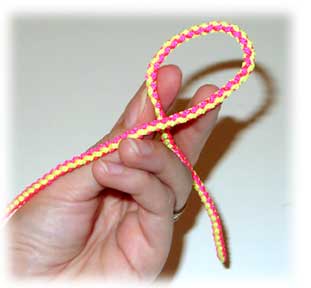
- Make a second loop in front of the first - it will look like a figure-8.
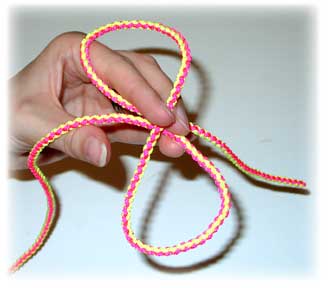
- Bring the tag towards you and lay it between the two loops splitting them.
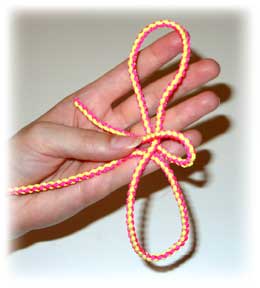
- Reach through the first loop and grab the second loop. When using monofilament, use a coat hanger or another wire to reach through.
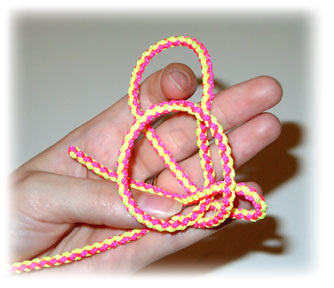
- Pull the second loop through, but don't pull too much - only enough to fit snugly around the wire. When using monofilament, use needle nose pliers at this point to pull the knot snugly around the coat hanger. Nooses can be made up in large quantities and stored looped around a coat hanger at this point, then pulled off and attached to a trap as needed.
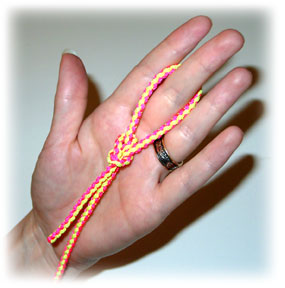
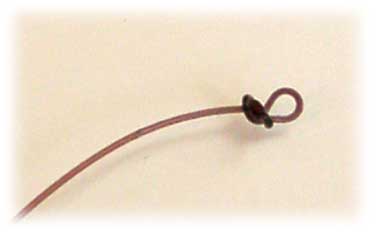
The Perfection Loop as tied in monofilament. There is a clean, open loop for the length of the noose to slide through without locking. 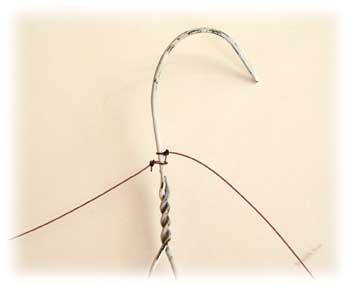
The Perfection Loop stored on a hanger. This makes for easy storage and care. As you make the knots, you just slide each one over the hanger and tighten it with pliers. When you are ready to affix them to a trap, you remove one at a time and can hang the rest up until you need more. - Take the long end of the line and feed it through the now locked loop. The line should slide freely through the loop without the loop closing on it. This is now a noose that will catch a bird's feet.
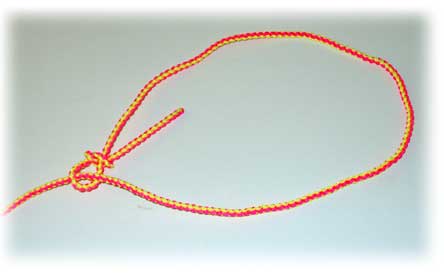
To attach a noose to a trap, use the Improved Clinch Knot, again, using a cord instead of monofilament.
- Lay the line under a piece of the wire. You will have the long end with the Perfection Loop on one side and a shorter tag on the other side.
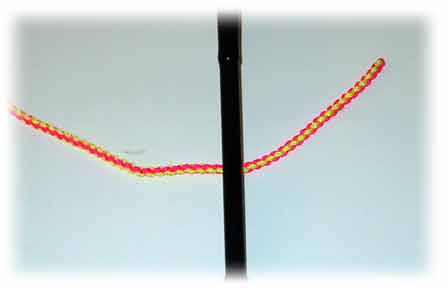
- Above the wire, twist the tag and the line three times.
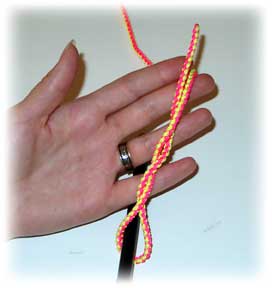
- Pass the tag under the twist so that it is between the twist and the wire. You will form a loop. Leave the loop slightly open - do not pull the tag taut.
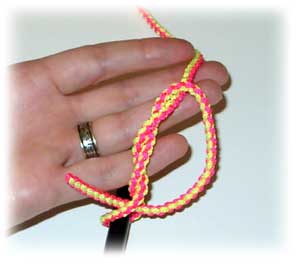
- Pass the tag through the loop you just created.
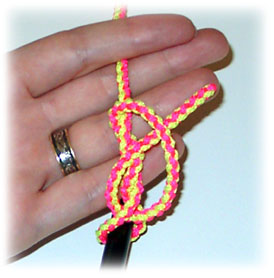
- Use needle nose pliers to pull this tight on the wire. When tight, you can trim the tag short and position the knot so that it is on top of the wire. The knot will cause the line to stand up slightly.
